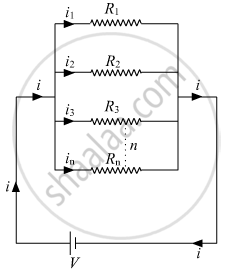Advertisements
Advertisements
प्रश्न
Answer the following question.
With the help of a suitable circuit diagram prove that the reciprocal of the equivalent resistance of a group of resistances joined in parallel is equal to the sum of the reciprocals of the individual resistances.
उत्तर

Let there are n resistances, each of value RI, R2 Rn, respectively, are connected in parallel to a battery of voltage V. if the equivalent resistance of the circuit is Req, then-current drawn from
`"i" = "V"/"R"_("eq")`
the battery is
The total current /then divides into Ii, i2, i3 in, respectively in the given resistors. As all the resistances are connected in parallel, hence the voltage across each resistor is V Volt. Now we can write,
i= i1 + i2 + i3 + ...........+ ieq
`"V"/"R"_("eq")="V"/"R"_1+"V"/"R"_2+"V"/"R"_3.......+ "V"/"R"_"n"` ......(1)
From eq. 1,
`1/"R"_("eq")=1/"R"_1+1/"R"_2+1/"R"_3......+1/"R"_"n"`
Hence, reciprocal of the equivalent resistance is equal to the sum of reciprocal of each resistor joined in parallel
APPEARS IN
संबंधित प्रश्न
Explain with the help of a labelled circuit diagram how you will find the resistance of a combination of three resistors, or resistance R1, R2 and R3, joined in parallel. Also mention how you will connect the ammeter and the voltmeter in the circuit when measuring the current in the circuit and the potential difference across one of the three resistors of the combination.
Explain the construction and working of the following. Draw a neat diagram and label it.
Electric motor
In any electric circuit, when the switch is on and the current flows through it why do the wire, switches, bulb or devices become hot?
Find the odd one out and give its explanation.
Study the three electric circuits below. Each of them has a glass rod (G), a steel rod (S), and a wooden rod (W).
In which of the electric circuits would the bulb not light up.

In a simple circuit, why does the bulb glow when you close the switch?
In an electrical circuit three incandescent bulbs A, B and C of rating 40 W, 60 W and 100 W respectively are connected in parallel to an electric source. Which of the following is likely to happen regarding their brightness?
Observe the circuit given:
1. Would any of the bulbs glow when the switch is in the ‘OFF’ position?

2. What will be the order in which the bulbs A, B, and C will glow when the switch is moved to the ‘ON’ position?
Paheli connected two bulbs to a cell as shown in Fig. 12.8.

She found that filament of bulb B is broken. Will the bulb A glow in this circuit? Give reason.
How is Joule's law effect useful in electric circuits where fuse is used as a safety device?
